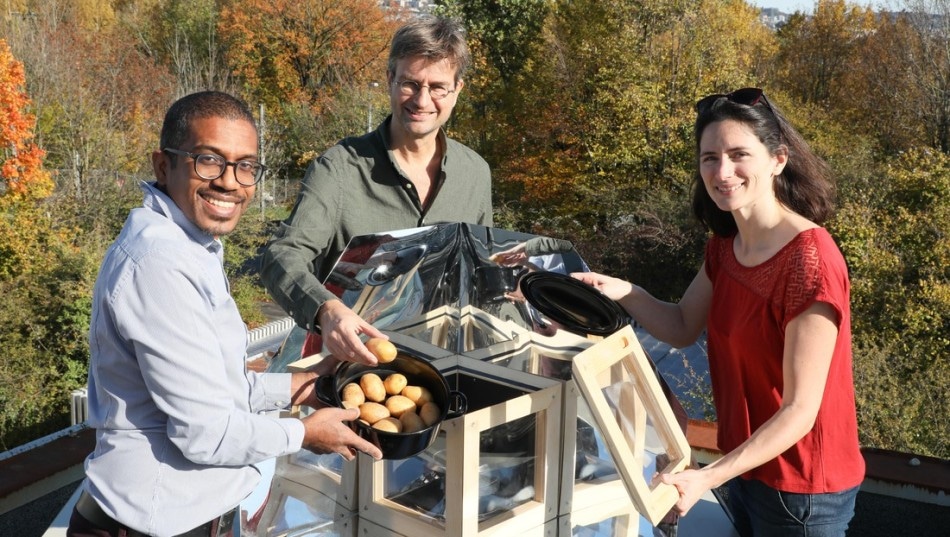Nov 18 2019
Researchers at EPFL have built a glass-paneled solar cooker that provides excellent performance. Their patented design is designed to work an average of 155 days per year in the cloudiest areas of Switzerland, and up to 240 days in the sunniest days.
 The solar cooker and authors of the study on the roof of their lab. Image Credit: © Alain Herzog/EPFL
The solar cooker and authors of the study on the roof of their lab. Image Credit: © Alain Herzog/EPFL
Solar cookers—or solar-driven ovens—can be employed to cook foods at low temperatures (60–120 °C) ranging between 30 minutes to four hours. This makes them ideal for a variety of dishes, such as rice, vegetables, stews, potatoes, and even cupcakes.
Since 2018, EPFL researchers have been involved in creating an improved version of the traditional solar cooker. Details of the research have been reported in Solar Energy, in which they show how their design can operate in Switzerland’s sunniest areas, such as Valais Canton, for 240 days per year—or two-thirds of the year. In Switzerland’s cloudiest areas (such as Zurich), it can work for 155 days per year, a figure that astonished even the scientists.
The researchers involved in this work are part of EPFL’s Solar Energy and Building Physics Laboratory (LESO-PB). But how did building specialists become interested in cookers? “It all started with a chocolate cake—and it’ll all end with a chocolate cake,” says Andreas Schüler, a research associate at LESO-PB.
One day, Olivia Bouvard—a researcher at the lab—took a cake she had baked in a solar cooker to work. Her colleagues got interested in how these devices operate. They purchased one from Solemyo, an association located in Geneva, and started to reverse-engineer its design.
Like a Miniature Building
“A solar cooker is actually like a tiny building with glazed facades,” says Schüler. This was something he could easily relate to, since he has been involved in an advanced window-glazing technology for the last few years.
Schüler and his colleagues at LESO-PB made enhancements to the cooker’s size they had ordered and incorporated more glazing—using, naturally, their advanced type of glass. That improved the amount of sunlight reaching the cooker, and because of the better insulating properties of their glass, it did not increase the amount of heat loss.
The researchers partnered with the Swiss Design Center to develop a prototype of their model, and they filed for a patent in 2018. Then, using an EPFL Enable grant and an ENAC InnoSeed grant endowed the same year, they collaborated with TZ Menuiserie SA—a carpentry company located in Valais—to produce 10 prototypes.
The EPFL model has been engineered especially for Switzerland. Along with glass, it uses pinewood and is surrounded with aluminum to reflect and direct the sun’s rays. The cooker’s shape and glazing are designed to form a “sunlight trap” so that it does not have to be shifted during cooking to track the sun’s rays. Measuring 33 cm x 33 cm, it is sufficiently large to hold a typical casserole dish.
“We also looked into the idea of creating a collapsible, portable cooker, along with a fold-up casserole dish, that people could use when they go hiking or to the beach,” says Schüler, who himself is a happy owner of one of the models.
We believe our cooker could help reduce the load on Switzerland’s power grid during the peak lunch and evening hours. Cooking is the third-biggest use of household power in Switzerland, behind heating systems and water boilers. With our cooker, you could put all the ingredients in before going to work, for example, and have a meal ready for you when you get home—without using gas or electricity.
Andreas Schüler, Research Associate, LESO-PB, EPFL
Designs for Other Countries, Too
The technique for calculating the number of days the solar cooker could work in a year was formulated by Dasaraden Mauree, a LESO-PB researcher dedicated to modeling methods.
We combined climatic data for Switzerland with our cooker’s operating data to develop a mathematical model that can subsequently be used for any other region in the world.
Dasaraden Mauree, Researcher, LESO-PB, EPFL
The researchers tested their model by gathering data from their cooker for 30 days, on the roof of their lab, and comparing the data with the model’s forecasts. Besides ratifying the model, these tests revealed that their solar cooker, when fitted with aluminum reflectors, can provide 55% more cooking days annually compared to the same cooker without reflectors.
The researchers are involved in further boosting their cooker’s efficiency and on transforming it into a “smart cooker” by including an app that would allow users to keep track of the oven when they are not at home by transmitting an alert when a meal is prepared. They are also hoping to modify their design so that it can be used in other countries through a technology-transfer method.
We’ve had Master’s students work with us on this project, and their ideas and enthusiasm really helped us move it forward. We owe them a lot!
Andreas Schüler, Research Associate, LESO-PB, EPFL
They can apply the insights learned while creating the cooker to their research on making buildings stronger. Therefore, after turning their focus from buildings to cookers, the scientists can currently apply the insight they gained from cookers on buildings.